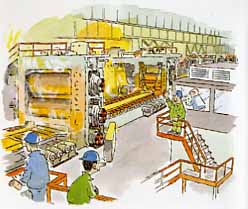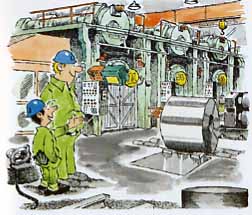


Well over half of the steel we make ends up as sheet and strip products. This includes the hot and cold rolled sheet and strip described in this section, and the flat rolled coated products you'll read about next.
Both steel sheet and steel strip are thin (less than 1/2 inch), flat products. The major difference between them is width. Sheet can be up to 75-inches wide, while strip is less than 24-inches wide and may be as narrow as 1/2 inch. Generally speaking, the thickness of steel strip is more tightly controlled than the thickness of sheet.
These products have countless applications: sheet is used to make automobile bodies, appliances, cabinets and many other familiar products. Strip is transformed into seat belt buckles, chain saw blades, washers, machine parts and many other "small" steel products you see every day.
The first step in making sheet and strip is to heat a slab of steel to proper hot rolling temperature, somewhere above 2100°F. Next, the scale on the slab's surface, essentially a thick layer of rust, is broken loose by the action of heavy steel rolls and high pressure water sprays. Then, the red-hot slab passes between several pairs of rolls in the hot strip mill (above). The rolls squeeze the steel down to the proper thickness, and in the process, increase the slab's length to upwards of 2000 feet.
As hot rolled sheet or strip emerges from the rolling mill, it is wound into coils or "bands" for easy handling (above). Some of the bands are shipped to customers, but others are sent to J&L mills to be cold rolled.
Cold rolling is also accomplished by squeezing the steel between pairs of hardened rolls. It reduces thickness even more, improves the surface finish and makes the dimensions of the sheet or strip more uniform.
Cold rolling tends to harden the steel,
and often this is not desirable in sheet or strip applications.
For this reason, most cold rolled sheet and strip is softened
by heating it to carefully controlled temperatures in an annealing
furnace. Then, the annealed product is run through the rolls of
a temper mill to re-harden it slightly, and to give it proper
flatness and surface quality.